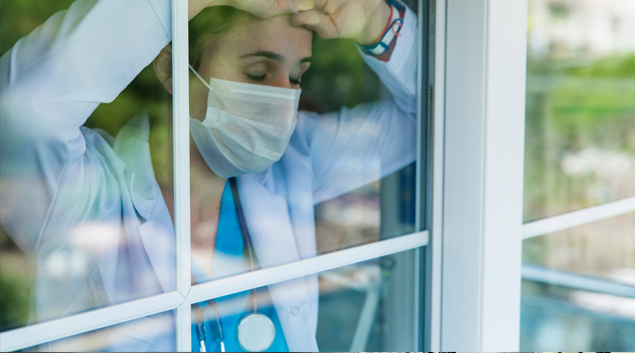Cost of burnout-related physician turnover totals $5 billion annually

Cost of burnout-related physician turnover totals $5 billion annually

Photo: AlenaPaulus/Getty Images
Frenzied work conditions during the COVID-19 pandemic contributed to burnout among clinicians, but some of this hardship can be alleviated by letting healthcare professionals know they're valued and appreciated, and not going through their ordeal alone, according to findings recently published in JAMA Health Forum.
Analysts suggested that one means of addressing burnout and dissatisfaction would be to create a federal surveillance system that analyzed, in real time, levels of clinician and healthcare worker outcomes.
Clinicians have faced new sources of stress since the beginning of the pandemic, including fear of the virus, inability to modulate workload, changes in childcare and eldercare responsibilities, requirements for care that is felt to be ethically untenable (such as rationing), and some degree of questioning their meaning and purpose in the profession, researchers found.
These stressors have led to clinician exhaustion and burnout, and a degree of turnover and exit from practice that is unsustainable.
WHAT'S THE IMPACT
Based on surveys of more than 20,000 U.S.-based physicians, data showed overall burnout rates at 49% over a three-year window.
Burnout was 45% in 2019 and declined through the year. There was a brief rise in early 2020 followed by a decrease during the early phases of the pandemic (40%-45%). Burnout increased toward the end of 2020 (50%), generally worsened throughout 2021, and showed a steep rise to the highest levels ever recorded by the fourth quarter of 2021 – about 60%.
But while burnout rates increased, the increase was lower if clinicians felt a sense of teamwork or being valued. In the fourth quarter of 2021, for example, burnout was 37% when feeling valued, vs. 69% when not.
Similar results were found when examining work environments, with lower burnout in calmer environments vs. chaotic environments (36% vs. 78%), and for those experiencing good teamwork vs. poor teamwork (49% vs. 88%). Importantly, teamwork burnout curves show modest improvement with good teamwork, but substantially higher burnout when teamwork is poor.
Burnout rates prior to the pandemic were falling in late 2019 and early 2020. At the start of the pandemic, there was a small, further decrease in burnout and intent to leave as healthcare workers came together for a common goal.
As time wore on, though, rates of burnout and intent to leave rose, and in late 2021 there were unprecedented levels of burnout (more than 60%) and intent to leave the job (more than 40%), perhaps due to a combination of depletion, exhaustion and the sense of no longer being valued by organizations or even patients. This late 2021 peak in burnout occurred concurrently with a national rise in work departures known as the Great Resignation.
Meanwhile, feeling valued and good teamwork were associated with favorable outcomes. How to make clinicians feel valued is still being explored, but general principles include having a receptive leadership team that listens to frontline workers and makes tangible changes based on feedback and needs, and providing organizational support for work-life integration, as well as clinician self-care. The benefits could be substantial, as only 45% of clinicians felt valued in 2021.
Cost savings to address these issues could be considerable, as current annual cost estimates place burnout-related physician turnover at about $5 billion.
THE LARGER TREND
With a projected shortage of nearly 140,000 physicians by 2033, and a shortage of three million lower-wage healthcare workers in the next five years, U.S. Surgeon General Dr. Vivek Murthy sounded the alarm on the country's ongoing healthcare burnout crisis in May.
Health workers – including physicians, nurses, community and public health workers, and nurse aides – have long faced systemic challenges in the healthcare system, even before the COVID-19 pandemic. That, according to Murthy, is leading to crisis levels of burnout.
The pandemic, of course, only made things worse, prompting Murthy to issue an advisory for addressing health worker burnout that includes recommendations such as reducing administrative burdens, being more responsible to workers' needs and eliminating punitive policies for seeking mental health and substance use disorder care.
The Department of Health and Human Services said in January that American Rescue Plan money is funding $103 million to 45 grantees over three years to retain healthcare workers and to address burnout. The funds will also promote mental health and wellness and also go to training, with a focus on underserved and rural communities.
Twitter: @JELagasse
Email the writer: Jeff.Lagasse@himssmedia.com
1669657287